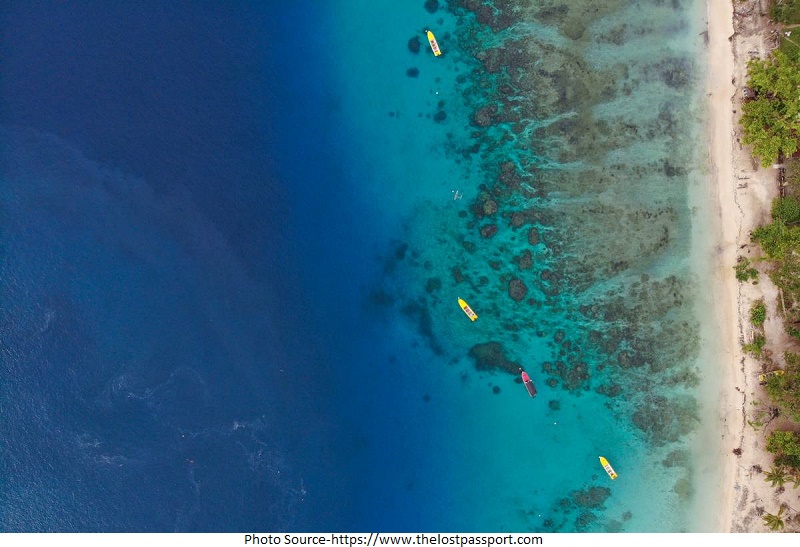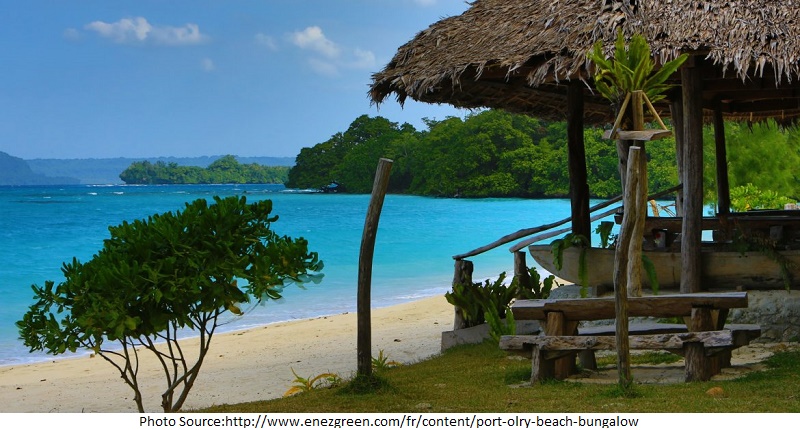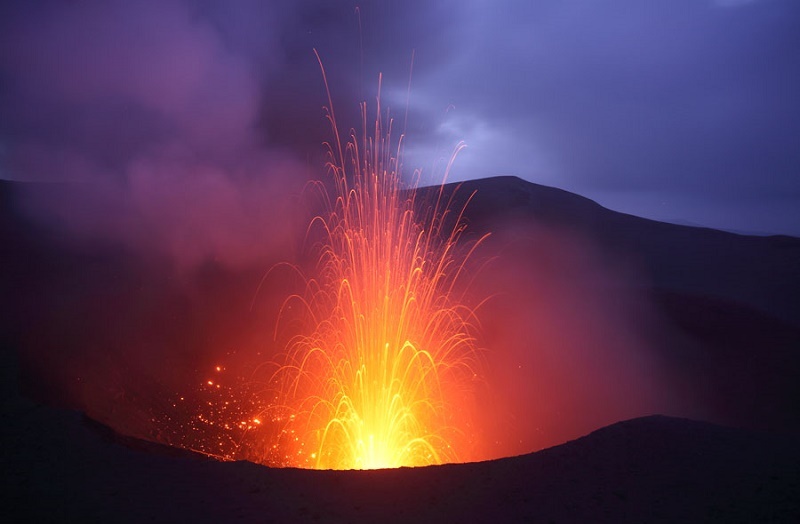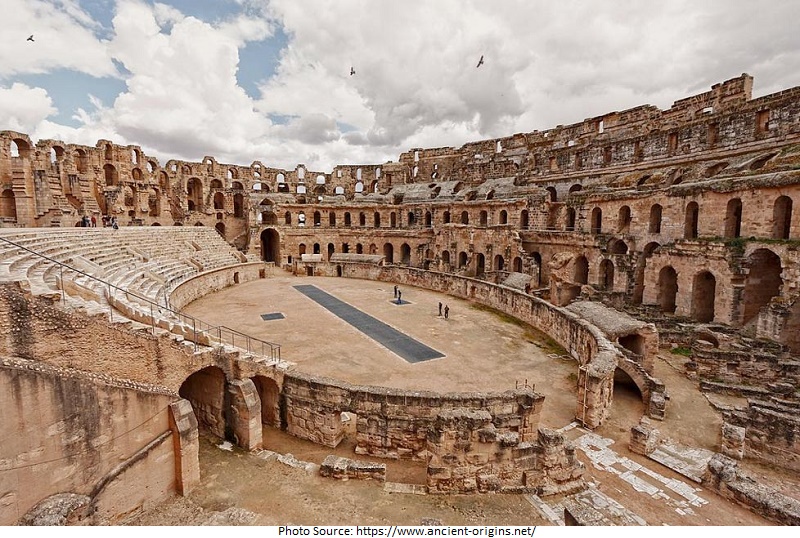20 Best Tourist Attractions to Visit in Vanuatu
1. Mt. Yasur Volcano

The world’s most open active volcano, Mount Yasur, is restlessly bubbling away on Tanna Island, a 45-minute flight from Port Vila. Just how approachable is it? You can drive nearly to the peak – it’s approximately a 10-minute walk from the car parking region to the lip of a continuously erupting volcano. The experience up the crest is one you won’t easily forget, as liquefied rock gleams red when it’s cast into the air, and the rumble and hiss of emitting gases causes one of the best natural phenomena on the earth. Some tourists find Yasur frightening; others fascinating. Photographers are beside themselves at the chance to take nature at its most fury from such a convenient point. A stable tripod is a must for the best captures. The finest times to travel Yasur are only before sunrise and for an hour or two after sunset. Complete darkness is the absolute thrill. The activity level of Yasur surges between risky and comparatively calm. It’s mostly more active after the rainy season; check the recent alert level. If the volcano is touching activity levels three and four, access to it won’t be granted. This live volcano is one of the best tourist attractions in Vanuatu.
2. Port Villa

Standing on the beautiful Vila Bay and a chain of lagoons, beaches and off-coast islands, Port Vila is a stunningly concise but forceful city. It’s a little jagged around the sides, with a few traffic-loaded high ways providing up to a supply of souvenirs, marketplaces, and waterfront restaurants and cafes with several lasting French influences. Underneath this veneer is a strange blend of vacationer, cruise ship day-trippers, expats and yachties, along with ni-Van drawn from all over the islands. This is the busiest city in Vanuatu, with an overwhelming array of travel and adventure activities, different outstanding restaurants, bars, supermarkets, banks, and marketplaces.
3. Luganville

Luganville is Vanuatu’s ‘second city’, with an extended, relaxed key street going side by side to the waterfront. Apart from the outlook across the channel to Aore Island, it’s not an exceptionally fascinating city, but with a good range of accommodation, several refreshing cafes and kava bars, many dive and travel operators and a bustling market, it’s a fantastic place to hang out or base you for tours around Santo.
4. Mt. Benbow and Mt. Marum

The guided tour up these couplet volcanoes is feasibly demanding and the scene is mostly shadowed by low cloud and volcanic smoke and ash. But on a lucid day, the prize for your ascending will be squinting into a live crater and watching the red-molten magma boiling below like a devil’s pot of tomato soup. The volcanoes are closely observed, ascending is sometimes adjourned on high-activity days and banishment plans are constantly ready. To ascend, you must be fit and cozy walking on sheer terrain and you need an efficient guide (compulsory). Sun Screen cream and plenty of safe drinking water are indispensable. There’s an arid, slippy crust around both volcanoes so your boots need to be sturdy enough to kick toe holes. Ankle backing is also essential as there’s some boulder hopping. Amidst the mountains, the walk over the razor-backed sierra gets very slender and serpents dangerously upwards, while outlet all around erupts acerbic smoke. Mother Nature does her best to be intimidating. The finest idea is to climb up one way and down another (several guides will encounter you on the caldera). There are three ways, two approached from Craig Cove airport and one from Ulei airport.
5. Malekula

Formed like a sitting dog, Malekula has two uplands regions linked by ‘the dog’s neck’. It is one of the best tourist attractions in Vanuatu. The highlands are highly arduous and unwelcoming, climbing to over 800m and crisscrossed by slender valleys. Two of Malekula’s prime cultural groups are the Big Nambas and Small Nambas, named for the reason of the size of the men’s Namba (penis scabbard). Small Nambas men put on one leaf of dried fiber wound around the penis and push into a bark belt. Their semi-kastom communities are constructed around tamtam, ready to pound a rhythm and a dance place. Big Nambas men wear large purple pandanus fibers around their penis, defending the loose ends in a fat bark belt and allowing the testicles exposed. They had such a wonderful battle like the reputation that no tourists presumed to venture into their zone. Even, police operations which came to penalize them for murdering businessmen were ambuscaded and scattered. They kept a stone fireplace where unwanted incomers were ceremonially cooked and devoured. Big Nambas’ erpnavet (grade-taking) rituals are preceded by lingering rehearsals. The men enwrap themselves in charcoal and coconut oil, knot nut rattles around their ankles and put on feathers in their hair. At the greatest level, a man has the mighty features of a hawk, and a hawk dance is accomplished by a spirit man.
6. Oyster Island

The fanciful resort on Oyster Island consists of a dispersing of distinct conventional-style bungalows (the finest are waterfront) and very well pleasant units. With just 32 beds, there’s a feeling of exclusivity but also a friendly, sensible family vibe. A host of travels are provided, including the distinguished Mt Hope Waterfall trip. Much of the products used in the restaurant is sourced regionally on the island – including the oysters. Call to order only a few hours ago for fresh oysters. The Sunday lunch buffet is a mythical extravaganza.
7. Champagne Beach

Champagne Beach is a beautiful horseshoe of mild white sand and turquoise aqua that gets very enthusiastic (slightly overhyped) reviews and consistent cruise-ship tourists. If you’re driving, keep the transport well back from the beach to escape from the extra charge. An improvised souvenir market constructs up when cruise ships are in.
8. Tanna

If you visit only a sole island outside of Efate, this should be it. Tanna is an outstanding place with the world’s most open operative volcano, magnificent isolated beaches and some of Vanuatu’s most wonderful traditional rural life. All these attractions made Tanna one of the best tourist attractions in Vanuatu. Except the raging Mt Yasur, the landscape offers vast rainforests, coffee plantations, mountains, hot springs, blue holes, and waterfalls, with some regions made into marine and wildlife conservations by native chiefs. Kastom is significant in conventional villages, where all natural happenings have the fourth dimension of spirituality and mystique, while bizarre cargo cults (John Frum and Prince Philip, specifically) still hold sway in different villages. Lenakel is the key town with a market, port, some shops, and a hospital. The volcano and maximum of the island’s key bungalows are about 30km southeast on the uneven cross-island road via a central fertile, deep forest, appropriately named Middlebush. The ‘road’ crosses Mt Yasur’s important ash plain on its way to Port Resolution.
9. Epi

A 40-minute flight from Port Vila, Epi is a pleasantly craggy and distant-feeling island where days can be passed snorkeling finding dugongs or inspecting ni-Van village life. On the north, the key destination is Lamen Bay from where you can advance across by boat to Lamen Island (almost 1km west) to locate turtles and plenty of marine life in the adjoining reef. A second access point is Valesdir in the southwest.
10. Pentecost

Pentecost is significantly abode to the naghol (land diving), the most noteworthy tradition in all of Melanesia, where men make sensational jumps of courage from lofty towers as a gift to the gods to secure a plentiful yam harvest. Pentecost is a long, slender island with an uneven interior, where truck tour can be achingly slow. Most of the people reside along the west coast, which has an immense rainfall, attributed to native rainmakers. A stony beach spread 12km from right before Lonorore airfield south to Ranputor. The south is the abode of the naghol (April to June). Pangi is the biggest village in the south but it’s quite basic, with only a kava bar, clinic, a couple of guesthouses and the NBV bank, which can exchange foreign currency in an exigency.
11. Millennium Cave

Trek and shamble through the forest, across an estuary, along with bamboo bridges and through small waterfalls to this huge cave, 20m wide and 50m high, nearly 15km from Luganville. Step down a bamboo ladder, and through a rocky basin sidestepping small waterfalls and small bats, and then out into the sunlight and into cold water to zap down the slopes past stunning colossal rocks, wonderful rainforest, and waterfalls. To enjoy an outstanding, full-day, guided-trip experience book at the office near Sarakata Bridge.
12. National Museum of Vanuatu

This amazing museum, in a lofty conventional edifice opposite the parliament, has a well-exhibited collection of conventional artifacts such as tamtam (slit gongs or slit drums), outrigger canoes, ritualistic headdresses, shell ornaments and instances of Lapita and Wusi pottery. There’s a fascinating photographic exhibition on the unearthing of Chief Roi Mata’s grave site. One-hour guided trips include a conventional instrument manifestation and sand drawing.
13. Mele Cascades

This beloved as well as panoramic swimming spot is 10km from Port Vila. A series of transparent aquamarine water tanks terrace up the hillside, ending up in a fascinating 35m waterfall streaming into a natural plunge tank. A slippy path with guide strings leads you to the summit. There are washrooms, change rooms and a cafe-bar with costless wi-fi at the access point. Go out by native minibus (250VT), or enjoy a guided trip with Evergreen.
14. Port Olry

At the top of the closed street, you come to Port Olry, a little French-speaking fishing village with an impressive arch of white-sand beach and eye-catching depthless turquoise waters. Three off coast islands can be arrived by kayak (500VT) or outrigger canoe (1000VT), where there’s wonderful reef snorkeling. There are a couple of fine cottage restaurants and bungalow operations on this spot, making it a glorious place to chill out for some days.
15. Port Resolution

Tanna’s finest harbor is this charming bay with fascinating cliffs and effortless entrance to east Tanna’s finest beaches. The Ireupuow village has an elemental shop, a marketplace and a couple of basic restaurants. To the left, a road head up to the native cliff-top ‘yacht club’ and to a marine sanctuary at Yewao Point where you can snorkel in the serene water just before the coral reef lasts. Another way reaches a gorgeous white-sand beach and a prime surf beach, with deep swells along 2.5km to Yankaren Para. Port Resolution is 8km away from the volcano gateway. A truck performs a return tour on Monday, Wednesday and Friday mornings from Port Resolution to Lenakel (2000VT), in another way organize a charter.
16. Hideaway Island

About 100m or so off the coast from Mele Beach, Hideaway Island isn’t all that concealed but it’s one of Vila’s beloved places for snorkeling, diving or only dining lunch at the island’s resort (nonguests can enter the marine park until 4 pm). The costless ferry putts out from in front of the Beach Bar usually and once on the island you can snorkel in the marine sanctuary, enjoy a dive trip and send a waterproof postcard from the world’s sole submerged post office.
17. Efate

Efate is Vanuatu’s key island, politically, economically, industrially and according to population and tourism. Even so, outside of the capital Port Vila, it’s somewhat laid-back with some of the village life you’ll see on other islands. Efate has two of Vanuatu’s finest deep-water harbors in Vila Bay and the extending Havannah Harbor, as well as the main airport. Drive around the island’s closed ring road (inaugurated in 2011) to explore its bays and beaches, islands and creeks. It’s also effortless to enter distant-feeling off coast islands such as Pele, Nguna, Moso, and Lelepa.
18. Erakor Island

Erakor is one of Port Vila’s wonderful resort islands. Day travelers can swim and snorkel at the depthless white-sand beach, kayak around the island or eat in the Aqua Restaurant (the day spend is amendable for food and drinks). The 24-hour ferry departs from the top of the road past Nasama Resort.
19. Loru Conservation Area

Spreading over 220 hectares, Loru Conservation Area holds one of the last fragments of lowland jungle remaining on Santo’s east shore. There are some wonderful nature walks, plenty of coconut crabs and a bat cavern, which the villagers utilize as a cyclone shelter. Turn at the guidepost off the East Coast Rd down a dirt road for 4km to Kole 1 Village. If you’ve reached without a guide, ask for Kal. The guided walk requires nearly half an hour.
20. Ekasup Cultural Village

Futuna islanders speak about and exhibit their conventional lifestyle at their kastom village. If you’re not advancing out to additional islands, this is a wonderful cultural experience near to Port Vila. Reserve through Nafonu Tatoka Tours. Friday night is ‘Feast Night’, with shells of kava, amusement and buffet food. Reserve a day in advance.



Nice list it’s great
Thanks For Sharing Such beautiful information with us.
My opinion Mt. Yasur Volcano is Best area in Vanuatu